LIVE BLOG: Mauna Loa lava may soon reach Daniel K. Inouye Highway



COURTESY HAWAII DEPARTMENT OF LAND AND NATURAL RESOURCES
A lava fountain spews molten rock into the air on Mauna Loa, Wednesday, Nov. 30.

MARCO GARCIA/AP
Spectators watch the lava flow down the mountain from the Mauna Loa eruption near Hilo.

MARCO GARCIA/AP
People watch the eruption of Mauna Loa, Monday, Nov. 28, near Hilo, Hawaii. Mauna Loa, the world’s largest active volcano erupted Monday for the first time in 38 years.

COURTESY USGS
Fissure No. 3 is seen erupting this morning on the northeast rift zone of Mauna Loa Volcano on Hawaii island.
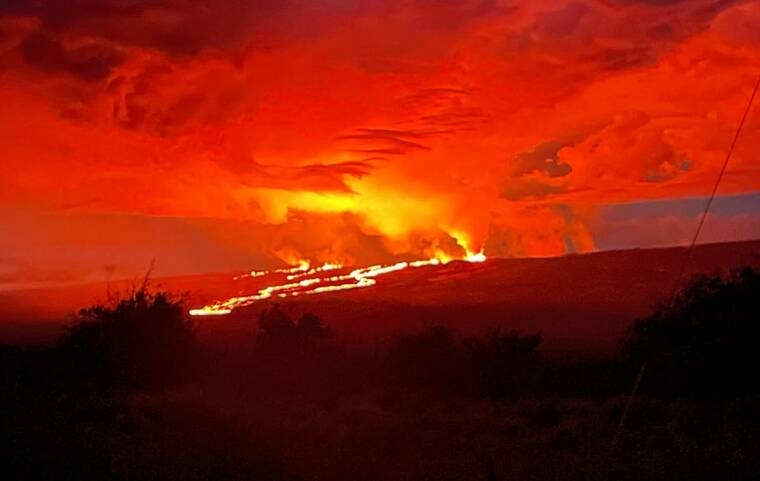
COURTESY DAVID FEE VIA USGS
Lava is seen Tuesday morning flowing north-northeast at Mauna Loa.
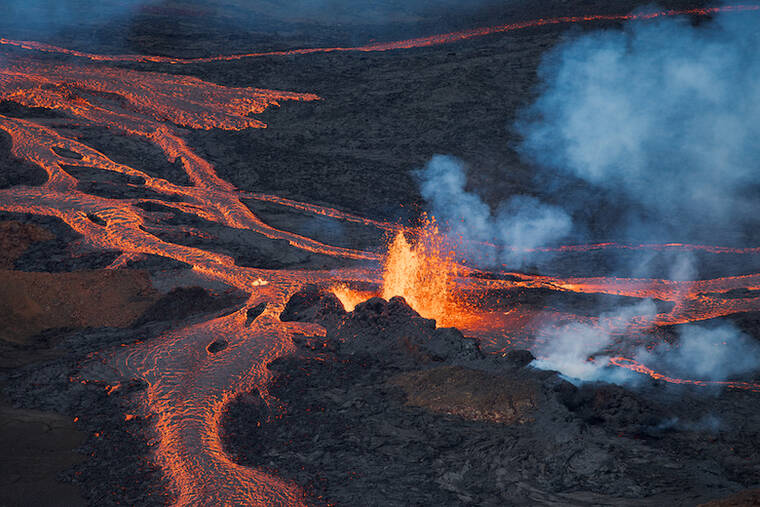
TOM KUALII / THEEDGEEXPLORER.COM / SPECIAL TO THE HONOLULU STAR-ADVERTISER
This view shows fountaining lava from the Mauna Loa eruption Tuesday morning.
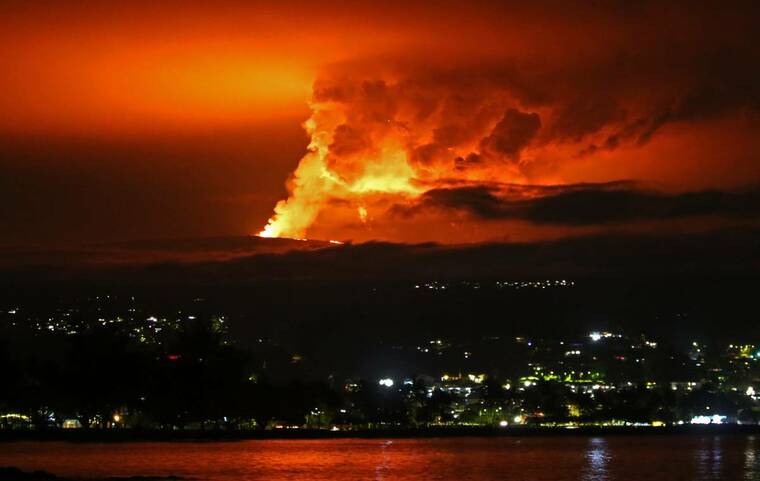
TIM WRIGHT / SPECIAL TO THE STAR-ADVERTISER
The Mauna Loa volcanic eruption on Hawaii island turned the night sky above the capital of Hilo reddish orange Monday night.
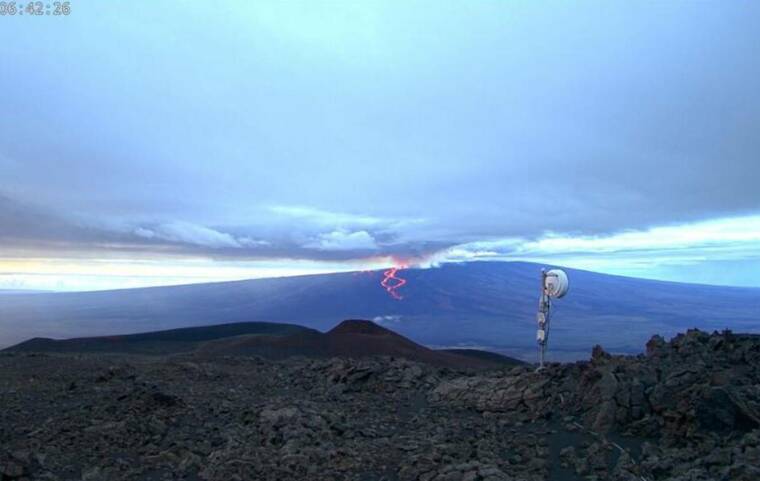
COURTESY USGS
A screenshot from the Mauna Kea webcam shows a wide view of the Northeast Rift Zone Tuesday morning.
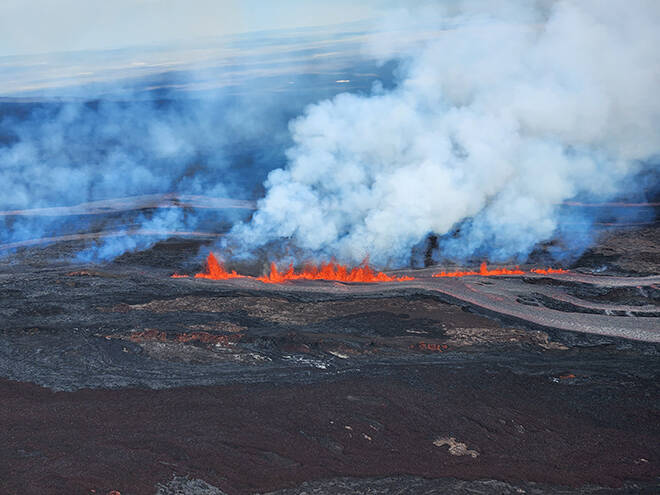
COURTESY USGS / K. Lynn
Lava fountains along a fissure on Mauna Loa’s northeast rift zone at about 9:30 a.m. on Monday.
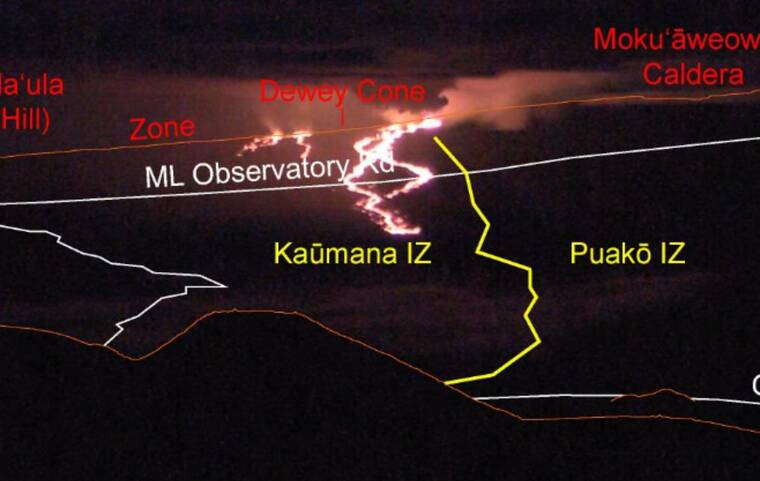
COURTESY USGS
An annotated view from the webcam on Mauna Kea shows the lava flow from Mauna Loa’s Fissure 3 moving north across NOAA’s Mauna Loa’s Observatory road overnight.












Editor’s Note: Bookmark this page! This story is developing and will be updated as soon as more information becomes available.
———
UPDATE: 4:30 p.m.
The Fissure 3 lava flows are traveling north toward Daniel K. Inouye Highway and remain about 3.6 miles from the critical transportation route, according to the Hawaiian Volcano Observatory.
These flows are beginning to slow and spread out as they reach the relatviely flat Saddle area.
The largest lava flow, fed dominantly by Fissure 3, slowed to a rate of 0.02 miles per hour between 7 a.m. and 12:30 p.m today, the U.S. Geological Survey said in a report.
Don't miss out on what's happening!
Stay in touch with breaking news, as it happens, conveniently in your email inbox. It's FREE!
Fissure 4 is still active with a lava flows moving northeast. A small lobe is moving east at a slower rate than the main lobe, USGS said.
Seismic monitoring of the site has detected tremor, or a high rate of earthquakes, in the vicinity of the active fissures, indicating that magma is still being supplied.
No active lava has been seen in Moku’āweoweo caldera and the Southwest Rift Zone is not erupting. USGS does not expect eruptive activity outside of the Northeast Rift Zone.
UPDATE: 11:30 a.m.
With authorities issuing $1,000 parking tickets to volcano watchers along Daniel K. Inouye Highway, officials are working to open up a new public viewing area at the Pohakuloa Training Area.
Hawaii island Mayor Mitch Roth told the Honolulu Advertiser’s Spotlight Hawaii this morning that he’s hoping the viewing area can be opened later today, but he wouldn’t be surprised if it took longer to get it up and running.
>> RELATED: Volcano knocks Mauna Loa carbon monitoring station offline
He said the effort involves two jurisdictions: the state and federal governments.
“I took a ride out there last night and the views are stunning,” he said.
Along the way, he saw one accident and plenty of people defying the parking restrictions he placed on the highway due to the dangerous conditions created when vehicles are traveling at a high rate of speed.
“You have people who are parking right next to the highway and they’re getting out with their phones and not paying attention to where they are going. And really that’s a recipe for disaster,” the mayor said.
10:25 a.m.
Lava has reached the bottom of the steep part of the Mauna Loa northeast rift zone and is now entering the Saddle area that is relatively flat 3.6 miles away from Daniel K. Inouye Highway, also known as Saddle Road.
Ken Hon, scientist-in-charge at the Hawaiian Volcano Observatory, said at the flow’s current rate, the lava will reach the highway in two days at the earliest.
“We expect it will probably take longer than that as the lava flow spreads out. It will probably interfere with its own progress, and we expect it to slow down,” Hon said at a news briefing this morning.
Fissure 3 is the dominant source of lava flow. It reached the Saddle area at about 7 a.m., while a smaller flow from Fissure 4 declined in productivity and is slowing down, he said.
Volcanic gas plumes were lofting high into the atmosphere this morning, Hon said, and there were reports of Pele’s hair (strands of volcanic glass) falling in the Saddle Road area.
Hawaii County Civil Defense Administrator Talmadge Magno said officials began discussions this morning about the possibility of doing something to try to divert the flow as it approaches the highway, a key traffic connection between East and West Hawaii island.
But those discussions, he said, didn’t go far.
Hon said diverting or stopping the flow would be extremely difficult.
“Lava diversion is a tricky thing to do, especially on flat ground,” he said. “It really comes down to a volume problem. What we’re seeing now is — take 10 of the biggest dump trucks you can think of, we’re getting that many dump trucks of lava every second delivered by this lava flow. So if you think you can pile up stuff in front of it faster than it can delivery stuff, you’re probably wrong.”
PREVIOUS COVERAGE
Mauna Loa’s first eruption in 38 years entered its third day today with several fissures active and lava flows moving in a northeast direction.
Fissure No. 3 has the longest and largest lava flow and fountains of lava between 131 to 164 feet high as of Tuesday afternoon, according to scientists at the Hawaiian Volcano Observatory.
Lava from Fissure No. 4, a smaller fissure that opened Monday night, is feeding lava flows in the northeast direction but still miles away from Saddle Road. Lava from the smaller fissure spouted about 16 to 33 feet high Tuesday.
At a news briefing Tuesday morning, Scientist-in-Charge Ken Hon of the Hawaiian Volcano Observatory said they continue to monitor the flow and hope to have an effusion rate on the lava output soon.
Meanwhile, Gov. David Ige issued an emergency proclamation relating to Mauna Loa Monday night.
“We’re thankful the lava flow is not affecting residential areas at this time, allowing schools and businesses to remain open,” Ige said in a statement Tuesday. “I’m issuing this emergency proclamation now to allow responders to respond quickly or limit access, if necessary, as the eruption continues.”
Hawaii County Mayor Mitch Roth also issued an emergency rule Monday night prohibiting parking and traversing on Daniel K. Inouye Highway, also known as Saddle Road, and its shoulders between mile marker 16 and mile marker 31 due to the influx of spectators driving and parking on the highway.
“We understand that many of our residents and visitors are excited to view the tremendous eruption happening on the slopes of Mauna Loa; however, it must be done in a way that ensures the safety of all of our community,” Roth said in a statement Tuesday.
“Saddle Road presents a number of unsafe conditions for pedestrian traffic, including rain, fog, and other factors that can reduce visibility for oncoming traffic — especially at night. Therefore, we ask that all who seek to view the eruption do so in areas that are deemed safe and in accordance with the law,” he added.
Under the emergency rule, only county, state or federal government employees and verified governmental contractors will be allowed to park in the area.
The public may park at the Gilbert Kahele Recreational Area which will remain open 24 hours a day until further notice. Security guards will be on site from 6:15 p.m. to 6:15 a.m. daily.
Jessica Ferracane, spokeswoman of the Hawaii Volcanoes National Park, said several thousand people visited the park Monday to view the Mauna Loa eruption. Viewing areas along the Kilauea caldera before sunrise Monday revealed a massive glow from the Mauna Loa caldera and a smaller lava lake within Halemaumau at the summit of Kilauea.
“This is quite a sacred event,” Ferracane said of the rare dual eruption.
County and HVO continue to caution that eruptions from Mauna Loa, the world’s largest volcano, can be unpredictable and long-lasting, and they recommend residents visit the county’s volcano hazards website Opens in a new tab for more information and updates.
County of Hawaii Supplemental Emergency Proclamation on Mauna Loa Eruption by Honolulu Star-Advertiser on Scribd



